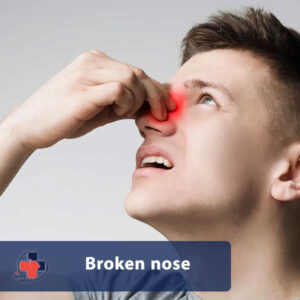The nose, a central feature of the face, comes in various shapes and sizes, contributing significantly to an individual’s appearance. While some people can identify their nasal type, others may need to consult a specialist for a thorough examination to determine their nasal characteristics. This article explores one of the most intriguing types of nasal surgery – thin skin rhinoplasty. Thin skin rhinoplasty is generally suitable for individuals with slender noses and thin skin, aiming to achieve the best possible appearance through surgical intervention.

Characteristics of Thin Skin Nose
Here are some common features of bony noses:
- Thin Skin: Bony noses typically have thin skin, which allows the surgeon to easily access the underlying structures. This can make the surgery easier and lead to more predictable results.
- Dorsal Hump or Bump: Many people with bony noses have a visible hump or bump on the bridge of their nose. This is often caused by excess bone or cartilage. During bony nose surgery, a skilled surgeon can remove this extra bone or cartilage to create a smoother and more proportionate nasal bridge.
- Narrow Nostrils: The nostrils, or nasal alae, are the fleshy parts on either side of the nose. In some individuals, the nostrils may appear wide or large. During bony nose surgery, the surgeon can narrow the nostrils to better match the rest of the nose.
- Defined Nasal Tip: The nasal tip is the lower part of the nose. In some people, the tip may be large or asymmetrical. A surgeon can reshape the nasal tip during surgery to make it smaller, more symmetrical, and aesthetically pleasing.
Overall, bony noses are often considered ideal candidates for cosmetic rhinoplasty due to their favorable structure. Thin skin, strong bones and cartilage, and a defined nasal tip are all factors that can help an experienced surgeon achieve natural and aesthetically pleasing results.
However, it is important to note that every person’s nose is unique and has its own characteristics. Therefore, the best way to determine whether bony nose surgery is right for you is to consult with an experienced rhinoplasty surgeon.
Thin Skin Nose Rhinoplasty Key Points
Professional Consultation: Before deciding on thin skin rhinoplasty, it is crucial to consult with an experienced rhinoplasty surgeon. They can provide comprehensive information about possible changes, surgical techniques, and expected outcomes.
Physical Preparedness: Preoperative tests and an assessment of your physical condition are necessary for thin skin rhinoplasty. Individuals with chronic conditions like diabetes or high blood pressure should discuss potential risks and recommendations with their doctor.
Expectations and Realities: Setting realistic expectations is essential. While thin skin nose surgery can improve the shape and size of your nose, the final result may differ from your imagination. Discuss your expectations thoroughly with your plastic surgeon to have a clear understanding.
Thin skin rhinoplasty benefits
- Improved Respiratory Function: It can enhance airflow and make breathing easier by addressing structural issues that may hinder proper ventilation.
- Enhanced Aesthetic Appearance: The correction of nasal bone shape can improve the overall appearance of the face, boosting the patient’s self-confidence.
Choosing the Best Nose Job Style for a Bony Nose
You can choose one of three styles for your bony nose surgery: natural, fantasy, or semi-fantasy. This is because bony noses have a strong structure. The firmness of this structure allows the surgeon to make various changes to the nose.
- The natural nose job style is suitable for those who want subtle changes and a natural look that is in harmony with the rest of their facial features.
- The fantasy (or doll-like) style creates a more stylized appearance for the nose and can be performed on bony noses. However, it may not be suitable for every type of face.
- The semi-fantasy style is a middle ground between the two previous styles. It is ideal for individuals who want noticeable changes, but not overly dramatic ones.
Choosing between these styles depends on various factors. Your facial structure, the original shape of your nose, age, gender, and even your job and lifestyle all play a role in selecting the best style for your bony nose surgery.
Who is suitable for thin skin rhinoplasty?
this surgery is suitable for individuals facing the following issues:
- Respiratory Problems: Individuals with structural nasal problems affecting breathing may benefit from thin skin rhinoplasty.
- Nasal Shape Discrepancies: Those dissatisfied with the appearance of their nose may find thin skin nose surgery helpful in achieving a more harmonious facial balance.
- Trauma and Accidents: Individuals who have experienced trauma or accidents resulting in nasal bone damage may require this kind of nose job to reconstruct and restore the natural appearance.
Is there any risk following thin skin nose surgery?
- Risk of Infection: Like any surgical procedure, thin skin rhinoplasty carries the risk of infection. Proper hygiene practices during surgery can minimize this risk.
- Potential Side Effects: Thin skin rhinoplasty may be accompanied by side effects such as bleeding, swelling, and pain. Returning to regular activities may take some time.
Recovery and postoperative care after thin skin rhinoplasty
After thin skin rhinoplasty, a certain period of rest and limited activity is necessary. The duration of rest depends on your specific case, so follow your doctor’s guidance for a smooth recovery. Adhering to postoperative instructions is crucial. This includes taking prescribed medications, using anti-inflammatory substances, avoiding nasal impact, and attending follow-up appointments with your doctor for evaluation.
- Rest and Relaxation: Adequate rest is crucial post-surgery. Limit heavy activities based on your doctor’s recommendations.
- Medications and Postoperative Care: Follow your doctor’s instructions regarding medication usage, including pills, drops, and anti-inflammatory substances. Proper care, including nasal irrigation and dressing changes, is essential for optimal healing.
- Preventing Nasal Impact: Avoid activities that could potentially impact your nose during the recovery period. Sports, heavy lifting, and situations where your nose may be at risk of injury should be avoided.
- Nasal Care: Maintain the cleanliness and dryness of your nose using nasal irrigation as per your doctor’s guidance. Gentle cleaning with saline solution is recommended.
- Postoperative Appointments: Schedule and attend follow-up appointments with your surgeon for assessments and adjustments. Your surgeon will monitor your progress and address any concerns that may arise during the recovery period. It is essential to stay in constant communication with your surgeon and address any questions or concerns. They are your best source of information regarding care and the return to normal activities.












